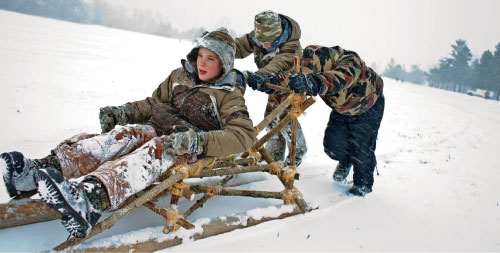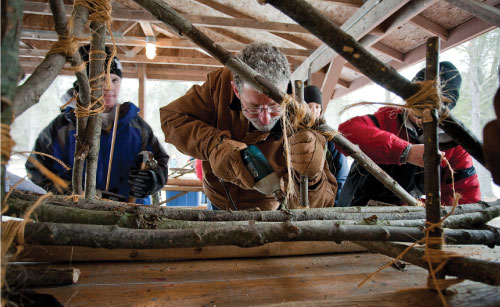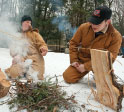Klondike Rush!
By Doug Smith
Photographs by Craig Van Der Lende
No hand-me-down, prebuilt sleds at this Klondike Derby. In an exciting return to the event's roots, these Scouts built their toboggans from scratch. And the race was on.
 Troop 320's Darrin Tenbusch (seated) felt like a king as he got some first-class transportation courtesy of Russell Tenbusch (left) and Matthew Hammond. |
One Friday evening last February, assistant Scoutmaster Dan Morgan watched with a smile as Scout Tim Wight labored in subfreezing temperatures with gloveless hands, lashing two sticks together with twine.
Tim and six fellow Scouts from Troop 111 in Lakeport, Mich., seemed not to notice the bitter, 15-degree cold. The boys were among about 200 Scouts and 75 adults from 17 troops of the Blue Water Council in Port Huron, Mich., who braved the frigid temperature to build their sleds and learn about winter camping.
“These guys are working pretty well together,” said Morgan, nodding to the bare-handed youths who chatted nonstop while building their craft.
Why were they building their sleds? you ask. Did the local REI run out?
Turn back the clock to 35 years ago when the organizer of the 2009 Klondike Derby at Silver Trails Scout Reservation, Scoutmaster Mike Timm of Troop 104, was in the same spot as these young boys.
“When I was here,” the father of two Boy Scouts said, “we built our own sleds. The whole point of sled building is to teach them teamwork. There’s a lot of different dynamics going on and a lot of life lessons, like learning how to get along with people.”
But the derby had changed since Timm’s childhood.
“In recent years, troops would bring premade sleds,” he explained. “This year, we’re not allowing sleds that were built by a troop 10 or 15 years ago and then dusted off to be brought out here each year.”
And no store-bought.
So instead of a modern derby with fancy, prebuilt sleds, the Scouts went back to the basics—making sleds from scratch like their predecessors.
Timm’s decision turned out to be one of the highlights of the Silver Trails’ Klondike Derby—for both the Scouts and the adult leaders.
“I like it,” Morgan said. “This is the way it used to be when I was a kid.”
Meanwhile, after several hours of determined work, first-year Scouts Nathan Hamilton and Myles McPherson of Timm’s Troop 104 put the finishing touches on their sled.
“It was kind of tough, but we didn’t give up,” Nathan said proudly. “It’s sort of lopsided,” he added, stepping back and sighting down the sled.
But it was functional, which drew a “Cool,” from Timm. “Good job, guys.”
Requiring the Scouts to build their own sleds on site meant the boys had to begin work as soon as they arrived in camp Friday night.
Many who had planned to camp overnight (and earn Polar Bear patches) erected tents or lean-tos in the woods and then gathered under a lighted picnic shelter to build their sleds. Others who arrived later built theirs Saturday morning.
Although some Scouts bunked in cabins, many snuggled into sleeping bags in tents or under lean-tos they had strung between trees. And most put straw and a tarp down to sleep on.
The youths slept under a clear, star-splashed sky with the temperature dipping to about 12 degrees.
Early the next morning, Scouts slipped out of their warm bags into the cold, and soon campfires crackled and pots clanged as breakfast got made. “No reports of cold feet or missing toes,” said Tom Ruedisueli, assistant Scoutmaster for Troop 168 in Port Huron.
Throughout the morning, the boys put finishing touches on their sleds, which all turned out looking similar—like dog sleds, low in front and higher in the back so that the “musher” could hold on.
 For authenticity, nails and screws weren't allowed, so Troop 333 Scoutmaster Raymond Welker used a drill to help Trevor Willing (left) and Austin Gillig insert wooden dowels into their sled. |
One patrol sawed its 8-foot runners in half to create a 4-foot-long sled, easily the smallest of the bunch. “We thought smaller would be better,” said Scout Matt Wilburn of Troop 223.
They varied mostly in quality. Some were straight and firmly lashed; others were a bit cockeyed and wobbly. They all held together, though.
An hour or so later, the patrols pulled their handmade sleds down a gravel road for the 9 a.m. flag-raising ceremony. Then the boys and adults checked out the sleds and gear, and the Scouts began their journey through the eight stations on the derby’s “Klondike Trail.”
No dogs, though (hey, this wasn’t the Iditarod). The Scouts towed their sleds using boy power.
By mid-morning, heavy snow had begun falling. Within minutes, the scene looked like something out of the Klondike Gold Rush, with several inches of the stuff on the ground.
Kevin Koveck, Troop 245’s Scoutmaster, certainly appeared to have stepped out of the Alaska wilderness in a coyote-skin hat with its tail drooping down his back.
“Everyone is having a great time,” he said. “The kids worked as a team. It’s a really good program. You teach these things at meetings, but they can actually do them here.”
And Bruce Ludington, Scoutmaster of Troop 168, which brought eight Scouts, said he was impressed with the revamped version. “I know my boys have learned some things about teamwork. We’ll be back.”
Once the Scouts hit the Klondike Trail, the fire-building station became a favorite stop. They had to build a fire tall enough to burn through twine suspended about 18 inches above the ground. But the exercise also tested their ability to follow directions.
The last page of the three-page instruction guide told them they could use the paper itself to start their fires. But many of the boys skimmed the instructions and missed this tip. Others spotted it immediately. Still others missed it but decided to use the paper anyway.
After the boys made it through each of the eight stations on the Klondike Trail, with the wind still blowing and snow still falling, they lowered the flag. But the fun wasn’t over just yet.
“Let’s go burn those sleds!” Timm shouted. That’s right. The event culminated with a spectacular “bonfire of the sleds,” ensuring that Scouts would have to build their crafts from scratch again at the 2010 event.
“We’re going to toast them,” Timm told the boys, “so that next year you can build a bigger, faster, better sled.”
The Scouts stacked their sleds on a huge pile at the edge of the field, and soon flames danced up toward the darkening sky. Everyone stood mesmerized by the roaring blaze.
“We just had a blast,” said assistant Scoutmaster Marvin Redlawski, whose son Luke is a first-year Scout. “[He] came with a little trepidation. Now he has a lot of confidence. I haven’t seen him have this much fun.
“That’s what Scouting is, building confidence and self-esteem.”
Doug Smith is an outdoor writer with the Minneapolis Star-Tribune.
Anatomy of a SledIn fairness, each troop received the same sled-making materials:
For safety and authenticity, no nails or screws were allowed. The sleds had to be sturdy enough to carry the patrol flag and the following winter survival supplies:
|
8 Stops on the Klondike Trail
|
 When construction was complete, Scouts towed the sleds to eight learning stations. Each stop provided troops the opportunity to earn “gold” nuggets that later could be used to bid on prizes—cook kits, camp saws, hatchets—that had been donated by each troop. Here’s a look at the stations.
When construction was complete, Scouts towed the sleds to eight learning stations. Each stop provided troops the opportunity to earn “gold” nuggets that later could be used to bid on prizes—cook kits, camp saws, hatchets—that had been donated by each troop. Here’s a look at the stations. Ice rescue
Ice rescue